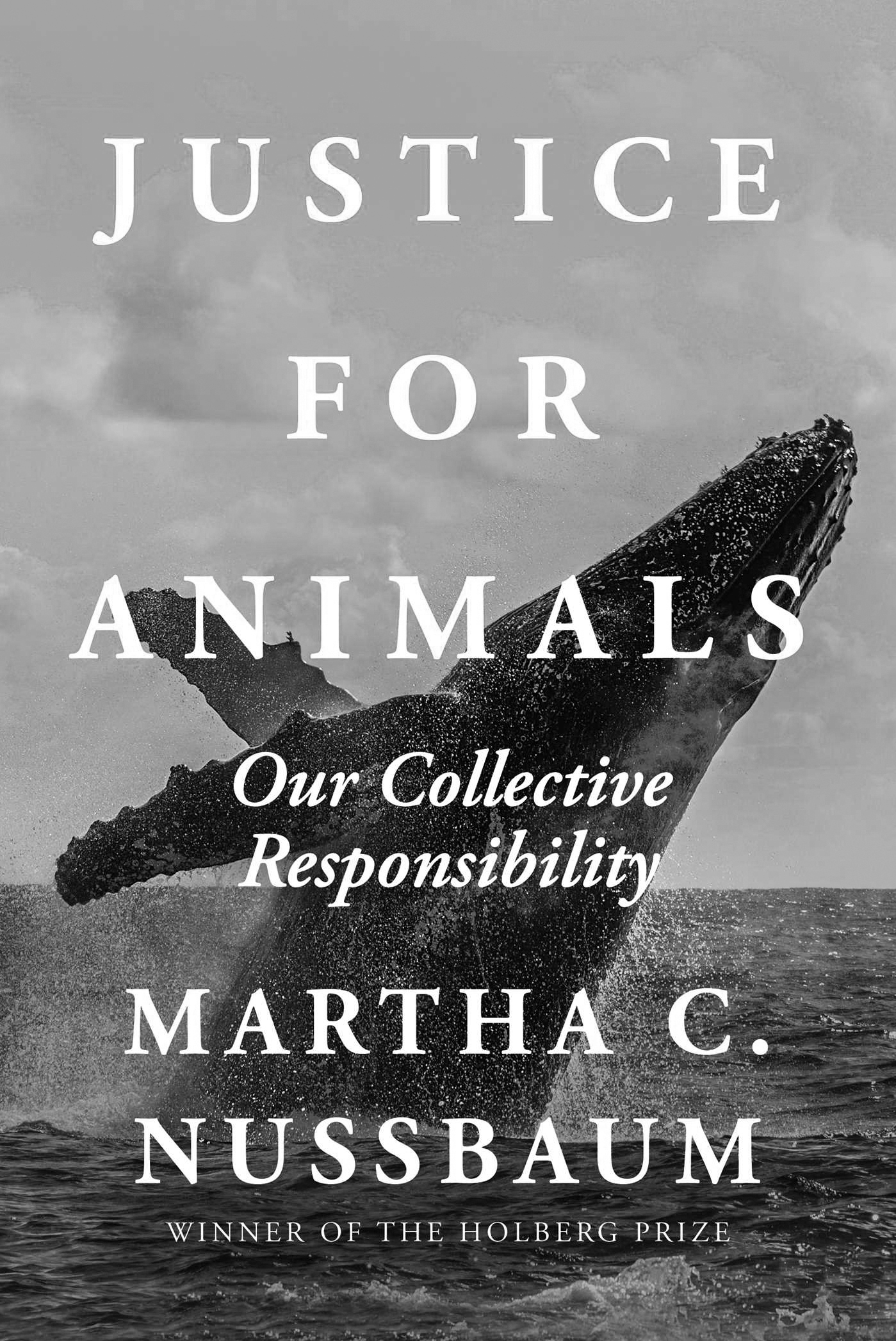Early in Martha Nussbaum’s new book Justice for Animals: Our Collective Responsibility, she writes in loving detail about a house finch that she listens to through a web database of bird songs: “Jean-Pierre is compelling to look at: such delicate gradations of color in his plumage, so active and intelligent as he socializes with other birds—and, above all, entrancing to hear as he spins his complicated warbling compositions. He never tires of singing.”
If you’ve heard of any contemporary academic philosopher, there is a decent chance that it is Martha Nussbaum. She is prolific (29 books) and prolifically decorated (63 prizes, 65 honorary degrees). She has written on — among other things — Hellenistic philosophy, political philosophy, international development, feminism, literature, disability, sex, and opera. Foremost, she is a philosopher of emotions. Since her early career as a classical philologist, Nussbaum has been interested in vulnerability, grief, anger, disgust, and love — what she herself refers to as our animal natures.
In this sense, Justice for Animals is a continuation of her long-term project: using philosophy, the stereotypical preserve of pure reason, to illuminate the parts of life and the living beings long considered as less than rational. A sense of love pervades Justice for Animals, which was written in honor of Nussbaum’s late daughter Rachel, an animal welfare attorney. Nussbaum loves the fastidious cleanliness of the pig, the echolocation skills of a dolphin who may even be able to tell that a human is pregnant before the human knows, the art of a bowerbird, which incorporates flowers and plastic with equal ingenuity, and the complex calls of a chickadee which have their own syntax. And she wants you to love them, too.
Nussbaum highlights three essential virtues in thinking about animals: wonder, which draws our attention to the value of animals; compassion, which alerts us to suffering; and outrage without the desire for retribution, which motivates us to improve the world. Compassion and outrage are common and valued in the animal advocacy community, but wonder is rarer.
The virtue of wonder is both amazement at animals’ unique ways of life and curiosity about why they behave the way they do. When we wonder at an animal, we recognize that their behavior has a purpose, that there is something it is like to be them, and we try to understand. Wonder, she writes, “takes us out of ourselves and toward the other… [It has] nothing to do with our own personal search for well-being. It is connected to our original joy at life itself.”
Nussbaum’s approach to animal ethics is the “Capabilities Approach.” Originally developed by Nussbaum and economist Amartya Sen as a political philosophy about humans, the Capabilities Approach says that societies should protect a set of basic “central capabilities” which are necessary for each individual to flourish. Although any individual might not wish to exercise any particular capability, the individual should still be able to, if they choose. For humans, these capabilities are as varied as eating nutritious food, reading, voting for those in power over them, planning the course of their lives, and relating to animals and the natural world. The Capabilities Approach is a theory of justice: Nussbaum argues that, as reasoning beings with inviolable dignity, we are entitled to the ability to exercise these central capabilities.
Nussbaum provocatively argues that animals are also reasoning beings with inviolable dignity, and so are entitled to the protection of their central capabilities. Factory farming is not merely a harm to animals; it is an injustice. In principle, allowing a wild animal to die of a treatable illness is no different from allowing a child to die of a treatable illness.
Both are unjust.
Many readers — even animal advocates — will find this view challenging. Instead of looking collectively at species or ecosystems, the Capabilities Approach requires us to treat each animal as an individual moral subject. Protecting the dignity of wild antelopes, cockatoos, and hammerhead sharks would require massive and costly interventions into nature. It is not clear how the Capabilities Approach treats the incommensurate central capabilities of predator and prey. It grants no special status to humans.
Nussbaum might respond to these challenges by reminding us that she is a political philosopher, not an ethicist. The Capabilities Approach is not, and is not trying to be, a definitive answer to the question of animal ethics, but an attempt to provide the basis for deliberations which will one day shape policy. It does not tell us how to advocate for animals, or even what goals we should advocate for – only the attitude to adopt before we start.
Nussbaum’s strongest disagreement with other strains of animal advocacy is with what she calls the “So Like Us” approach, which grounds animal justice in certain animals’ similarity to humans. Some people, such as animal-rights attorney Steven Wise, argue that we shouldn’t hurt gorillas because gorillas can be taught to use sign language to indicate their emotions. Because they can communicate with us in a way that we intuitively understand, they must be morally valuable. But even gorillas who use sign language don’t use it with each other. It’s a trick played with humans. Instead of valuing gorillas because they can be taught to playact as humans, using language in a similar way to us, we should value gorillas for the unique ways that they express empathy as gorillas, as well as the ways that they build nests, use tools, and wander across large ranges. If we say that birdsong and whalesong indicate that birds and whales are valuable because they sing just like humans do, then we miss the opportunity to appreciate birdsong and whalesong as unique forms of art created by minds that are very different from our own.
Nussbaum cares about justice for animals both because of how similar they are to us and because of how different they are to us. Animals are fundamentally unlike us, in everything from their mode of life to their sensory capabilities. Nevertheless, like us, they set goals and pursue them; like us, they struggle for life and fulfillment in a hostile world. Our amazement at the diversity of ways of being creates a desire for those ways of being to be lived out more fully.
In an earlier essay, Nussbaum describes her work on animal justice as “a neo-Aristotelian approach containing Kantian elements.”
From Kant, modulated by the work of her own former student Christine Korsgaard, she borrows the principle that sentient beings are ends in themselves; from Aristotle, the importance of attending to each species’s distinctive way of flourishing. What it is not, Nussbaum insists, is utilitarian.
Unlike classical Benthamite utilitarianism, the Capabilities Approach emphasizes the needs of members of each individual species to exercise their typical species capabilities. An elephant must have the capability to travel through a range thousands of miles wide; this ability is of no use to a house cat. Dolphins must be able to form social groups; polar bears have no such requirement. Utilitarianism, conversely, emphasizes the universal need of all animals to experience pleasure and avoid pain.
In line with her emphasis on a species’ capabilities, Nussbaum, therefore, grounds our concern for animals in “significant striving,” the ability to pursue the goals that matter most while setting aside those which are inconsequential. Utilitarians, however, care about whether an animal can suffer. Nussbaum argues that this distinction makes little difference in practice, because animals evolved to feel pain and pleasure so that they could prioritize between goals and pursue them in a flexible manner. Any organism that has the traits that the Capabilities Approach cares about, she claims, has the traits that utilitarians care about. However, this doesn’t fully justify her point. It is conceivable that some organisms, such as shrimp,
are able to suffer without necessarily having what we would call a significant aim. Would the Capabilities Approach be indifferent to their pain?
However, this disagreement is smaller than it seems – at least, smaller than it seems to Nussbaum. Under the Capabilities Approach, some central capabilities are shared by all animals, such as the capability to eat adequate and nutritious food.
Most utilitarians subscribe to a theory of animal welfare like the Five Freedoms Approach.
However, the Five Freedoms include “the freedom to express normal behavior,” that is, the behavior typical of a particular species. While the emphasis is different, the recommendations converge. Nussbaum herself seems to underestimate this convergence by arguing that utilitarians would accept (say) an elephant being fed and given adequate health care but denied a social group. Yet, loneliness is a pain, and social company is a pleasure. Utilitarian animal advocates take the ability of an animal to perform species-typical behavior very seriously. Perhaps Nussbaum’s underestimation is an attempt to differentiate her view from utilitarianism.
The primary distinction, I think, is one of attitude. The virtue of the utilitarian is compassion. The utilitarian grieves the suffering of (say) a lonely and isolated dolphin, calling out for podmates who aren’t there. The virtue of the follower of the Capabilities Approach is wonder. The follower of the Capabilities Approach has a deep respect for the way of being of the dolphin — their alien senses and ways of moving through the world, and yet how they — like us — have desires and longings, strivings and frustrations, and achievements. From that wonder grows an outrage that such a beautiful thing can be destroyed.
To some extent, it doesn’t matter what reason a person has to help animals as long as they help. But I think that wonder can provide a more robust motivation for animal advocacy. If we are simply concerned about suffering, then the enormity of the injustice done to animals (companion animals, research animals, farmed animals, wild animals) can lead to despair and a sense of helplessness. Rather, wonder allows us to experience a balancing joy in an animal’s life well-lived. We don’t just have something to avoid; we have something to aim for.
Dolphins can detect buried mines in harbors, a feat that human-developed sonar is incapable of. Octopuses in a lab squirt water at lightbulbs in order to burn the lightbulbs out and experience their preferred darkness. Chimpanzees have cultures: some groups have different grooming, courtship, tool use, and nest-building practices than others because of multi-generational social learning, not generational differences. The natural world is a place of wonder.
Show a young child a documentary about animals and you will see that the natural response to the diversity of animals — so strange from our parochial human view — is awe. But by adulthood, the awe, in this as in so many other areas of life, is stamped out. If we cultivate the wonder of a child, perhaps it will give us the curiosity, the compassion, and the outrage we need to begin to treat animals with justice.




